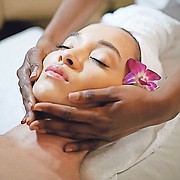Tuesday, November 12, 2019
By Kenya Mortimer-Mckenzie
The emphasis on achieving beautiful, healthy skin has seemingly never been greater than it is today.
But truth be told, we’re not the first society to look to improve the condition of our faces and skin in general. This desire has been pursued for centuries. In Egypt, Cleopatra was famous for her milk baths which were filled with lactic acid. And during the French Revolution, ladies of the court used aged wine on their faces to keep their skin flawless. In 1976, Drs Eugene Van Scott and Ruey Yu reported on the efficacy of alpha hydroxy acids on the skin – making it evident that we are not the first to discover the many benefits of alpha hydroxy acids.
Today, consumer interest in the benefits of alpha hydroxy acids has been marked by the constant coverage of the topic by leading beauty magazines and television talk shows. But what exactly are alpha hydroxy acids and what are the benefits to you? Let’s find out.
What are alpha hydroxy acids?
Alpha hydroxy acids are natural ingredients derived from food, such as sugar cane (glycolic acid), sour milk (lactic acid), apples (malic acid), fruits and aged wine (tartaric acid), and leaves of wintergreen and birch bark (beta hydroxy acid or salicylic acid). Glycolic acid has the smallest molecules of all the hydroxy acids, then lactic acid, and so forth. The smaller the molecule, the more effective it is in penetrating the skin. Glycolic acid appears to be the most effective for cosmetic purpose.
How do alpha hydroxy acids work?
The older we get, the more our skin’s ability to exfoliate slows down, resulting in an excessive build-up of dead skin cells. As a result, the stratum corneum (the outer top layer of our skin) becomes thick with dead skin cells. The skin appears dull, rough and dry. Using alpha hydroxy acids as an exfoliating agent in lower concentrations, between five per cent and 12 percent, helps to loosen and reduce excess layers of dead skin cells – gradually restoring fresher, smoother, healthier looking skin. Glycolic is great for the aging process of the skin.
Benefits of alpha hydroxy acids (Glycolic acid)
Glycolic acid has been intensively researched and known to address the following major skin concerns:
• Fine lines and wrinkles
• Oily skin
• Acne prone skin
• Rough, dry skin
• Uneven pigmentation (age spots)
• Razor bumps
Alpha hydroxy acids and chemical peel alpha hydroxy acids, such as glycolic acid, in high concentrations are used in chemical peels. The percentage of the glycolic concentration determines who can use it. A concentration of less than 10 per cent is sold to consumers. Trained skin care specialists can use a concentration of 20 percent to 30 percent. The percentage used by the skin care specialist can be referred to as a light facial peel. Doctors, on the other hand, can use higher concentrations of alpha hydroxy acids, such as 50 percent to 70 percent.
Why is it important for everyone to use the proper concentration?
As a consumer, not having the proper training in analysing and treating the skin, you can burn yourself if you apply a higher concentration of alpha hydroxy acids than recommended. The same applies to an aesthetician or skin care specialist who assumes the role of a doctor and exceeds the recommended concentration. The skin care specialist’s main responsibility is to deal with the top layer of the skin, the epidermis. The epidermis is where the hair follicles are, where dirt and oil are trapped, and midway of the epidermis is where the dead skin cells are.
Doctors, such as a dermatologist with a medical background, can use higher concentrations that allow them to work in the deeper layers of the skin. This is why they are called dermatologists; they work in the dermal layer of the skin where the blood vessels are.
This information is important to you as a consumer who is shopping around for the best skin treatments. You don’t want to end up as one of those people with a horror story about a bad chemical peel they had.
Another important factor when using alpha hydroxy acids is the pH level (a measure of its acidity). The pH balance of our skin varies from 4 to 6; normal pH is 4.2 to 5.6. When products are applied to the skin, the pH level can change. The closer the pH level of the product is to the normal pH the better. This is so important when getting a glycolic peel. If the pH is around 3.0 that is mild, but when the pH of the glycolic is below 2.0 it is considered a chemical peel which should only be administered by a doctor. The lower the pH, the stronger it is and deeper it goes into the dermis.
Safety concerns of alpha hydroxy acids
With a variety of skin care products containing alpha hydroxy acids available, here are some guidelines when deciding which alpha hydroxy formulation to use:
• Only choose one product that contains the proper formulation of alpha hydroxy acid to use as an exfoliant.
• It is best to use alpha hydroxy acid in a moisturiser.
• Cleansers with alpha hydroxy acids have minimal benefits because they are washed off without being absorbed into the skin.
• Sunscreen with UVB and UVA protection must be applied when using alpha hydroxy acids
• Alpha hydroxy acids are more effective at a concentration of five percent to eight percent and a pH of 3 to 4.
• The concentration information is not usually on the product label, but alpha hydroxy acids are more likely to contain the proper concentration when listed as the second or third ingredient on the list.
• A pH strip can be used to determine pH balance. You can also call the manufacturer.
• Discontinue product if you experience an adverse reaction such as burning.
Remember, when getting any alpha hydroxy treatment such as glycolic – whether by a skin care specialist or dermatologist – ask about the concentration of the AHA and the pH of the medium in which it is used.
• Kenya Mortimer-McKenzie is an anti-aging skin care specialist at the Baha Retreat Anti-Aging Spa. Visit www.baharetreat.com or e-mail kenya@baharetreat.com.

